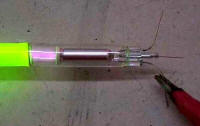
| Email John |
| Last update
02/17/2009
|
Masonlite Quicksilver Electrodes
- No mercury to handle
- Same dose for each tube
- No mercury trap
- Much cleaner pumping without the merc trap in the vacuum path
Unfortunately the problems overwhelm the advantages such that I only use these for special applications. Problems include:
- Not enough mercury for large tubes
- Mercury discharge is erratic
- Discharged merc tends to remain behind the electrode.

This is the electrode with the various parts identified. The mercury is contained within a capsule that is placed in the electrode glass where the tubulation would normally go. This is a very clever arrangement that requires very little tooling change.
The electrode itself is a conventional ceramic collar unit.
Production note: After struggling for longer than I care to think about trying to get a good photo of this electrode, it dawned on me that a transmission photo might work. I placed the electrode on a light box and the above photo resulted. A tip to keep in mind when trying to photograph a glass-encased object.

 Click to Enlarge
Click to Enlarge Click to Enlarge
Click to EnlargeThe arc between the merc capsule and the electrode shell heats the merc until it bursts the capsule.
 Click to Enlarge
Click to Enlarge Click to Enlarge
Click to EnlargeI address this problem by strongly heating the electrode with a heat gun. This drives the merc out to the main tube. It, of course, adds an extra processing step.

